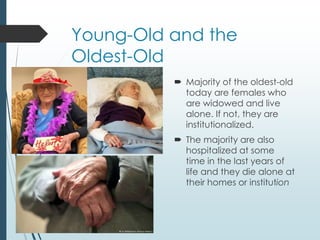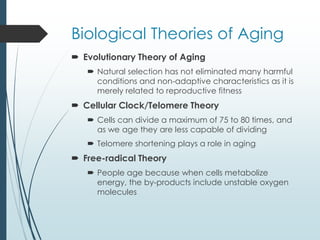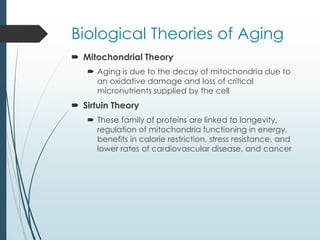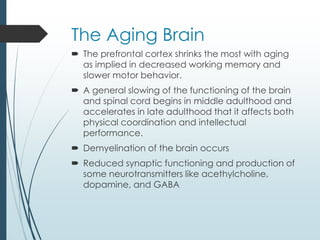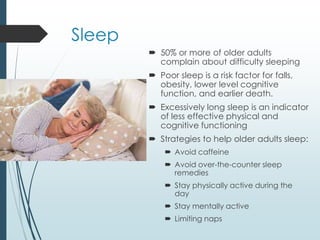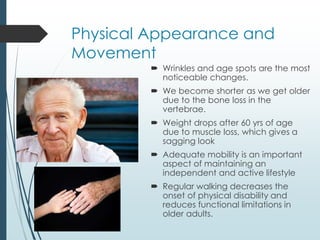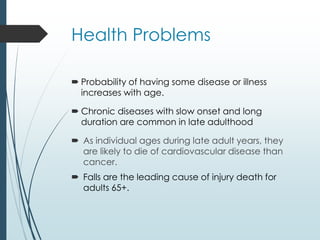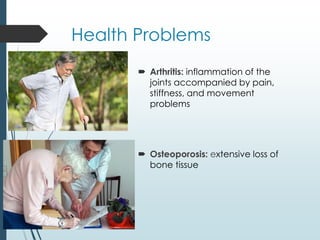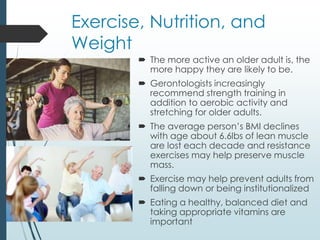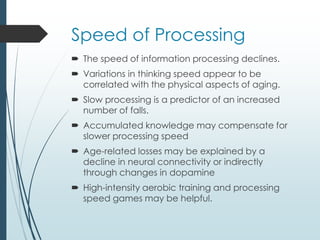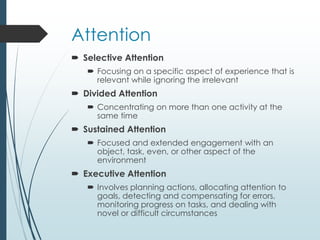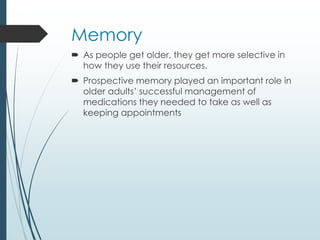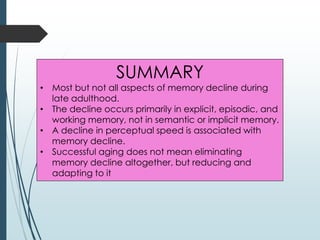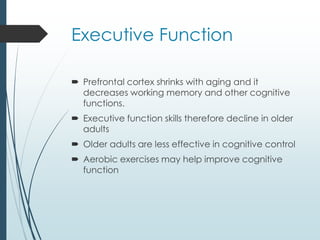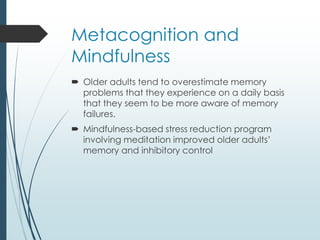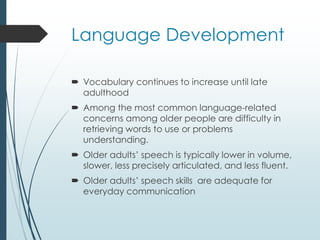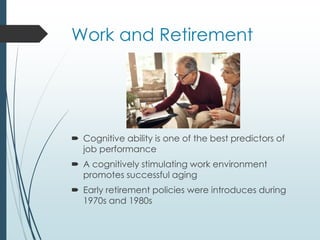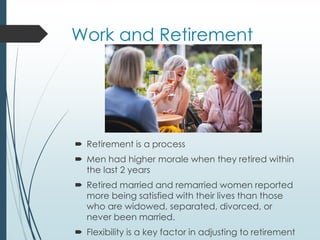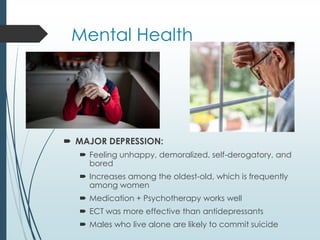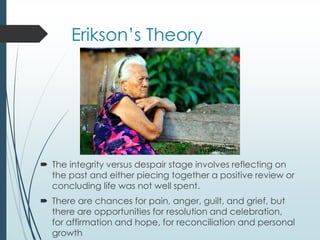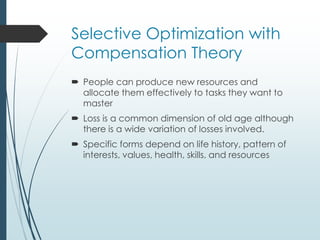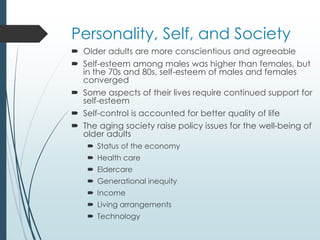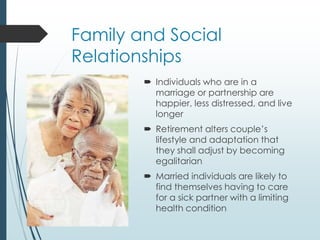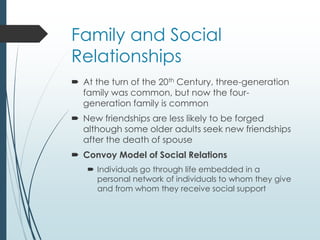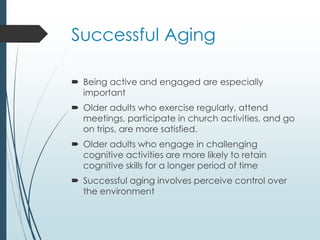Late adulthood
- 1. Late Adulthood © Tinnie Cruz, RPm San Beda College Alabang 1st Trimester AY2021-2022
- 3. Men are more likely than women to die from most of the leading causes of death such as cancer of the lungs, motor vehicle accidents, liver cirrhosis, emphysema and heart disease. In virtually all species, females outlive the males. Women have more resistance to infections and degenerative diseases. Genes and the ability to cope effectively with stress are associated with longevity. Social dynamics, personality, cognition, and socioeconomic resources and support systems contribute to the health and quality of life among older adults, including centenarians.
- 4. Young-Old and the Oldest-Old Young-Old = 65 to 84 yrs. of age Oldest-Old = 85 and older Sizable losses in cognitive potential and ability to learn; increase in chronic stress; a substantial prevalence of physical and mental disabilities; high levels of frailty; increased loneliness; and difficulty of dying with dignity are problems related to the oldest old. Young-old have the substantial potential for physical and cognitive fitness, higher levels of emotional well-being, and more effective strategies for mastering gains and losses of old age.
- 5. Young-Old and the Oldest-Old Majority of the oldest-old today are females who are widowed and live alone. If not, they are institutionalized. The majority are also hospitalized at some time in the last years of life and they die alone at their homes or institution
- 6. Biological Theories of Aging Evolutionary Theory of Aging Natural selection has not eliminated many harmful conditions and non-adaptive characteristics as it is merely related to reproductive fitness Cellular Clock/Telomere Theory Cells can divide a maximum of 75 to 80 times, and as we age they are less capable of dividing Telomere shortening plays a role in aging Free-radical Theory People age because when cells metabolize energy, the by-products include unstable oxygen molecules
- 8. Biological Theories of Aging Mitochondrial Theory Aging is due to the decay of mitochondria due to an oxidative damage and loss of critical micronutrients supplied by the cell Sirtuin Theory These family of proteins are linked to longevity, regulation of mitochondria functioning in energy, benefits in calorie restriction, stress resistance, and lower rates of cardiovascular disease, and cancer
- 10. Biological Theories of Aging mTOR Pathway Cellular pathway involved in the regulation of growth and metabolism as key aspect of longevity Hormonal Stress Theory Aging in the body’s hormonal system can lower resistance to stress and increase the likelihood of disease
- 11. The Aging Brain On average the brain loses 5% to 10% of its weight between ages 20 to 90. Brain volume also decreases. In healthy aging, the decrease is mainly due to the shrinkage of neurons, lower number of synapses, reduced length and complexity of axons, and reduced tree-like branching in dendrites, but only to a minor extent attributable to neural loss
- 12. The Aging Brain The prefrontal cortex shrinks the most with aging as implied in decreased working memory and slower motor behavior. A general slowing of the functioning of the brain and spinal cord begins in middle adulthood and accelerates in late adulthood that it affects both physical coordination and intellectual performance. Demyelination of the brain occurs Reduced synaptic functioning and production of some neurotransmitters like acethylcholine, dopamine, and GABA
- 13. The Aging Brain Some studies have documented neurogenesis in the hippocampus and the olfactory bulb. Among people in the 90s, dendritic growth no longer occurred, but may compensate for possible loss of neurons in the 70s. This may be accounted for by the lack of environmental stimulation. The decrease in lateralization is likely to play a compensatory role by the means of using both hemispheres
- 14. Sleep 50% or more of older adults complain about difficulty sleeping Poor sleep is a risk factor for falls, obesity, lower level cognitive function, and earlier death. Excessively long sleep is an indicator of less effective physical and cognitive functioning Strategies to help older adults sleep: Avoid caffeine Avoid over-the-counter sleep remedies Stay physically active during the day Stay mentally active Limiting naps
- 15. Physical Appearance and Movement Wrinkles and age spots are the most noticeable changes. We become shorter as we get older due to the bone loss in the vertebrae. Weight drops after 60 yrs of age due to muscle loss, which gives a sagging look Adequate mobility is an important aspect of maintaining an independent and active lifestyle Regular walking decreases the onset of physical disability and reduces functional limitations in older adults.
- 16. Vision In late adulthood, the decline in vision becomes more pronounced The visual field becomes smaller, a change suggesting that the intensity of a stimulus in the peripheral area of the visual field needs to be increased if the stimulus is to be seen. The visual decline can be traced to a reduction in the quality or intensity of light reaching the retina. Adults may have trouble distinguishing between objects of closely related objects. Depth perception declines, which makes it difficult for them to determine closeness or height
- 17. Vision Cataracts Thickening of the lens of the eye that causes a cloudy, opaque, and distorted vision Glaucoma Damage to the optic nerve because of a pressure from a buildup of a fluid in the eye Macular Degeneration Deterioration of the macula, which corresponds to the focal center of the visual field
- 18. Hearing Older adults often don’t recognize that they have a hearing problem, deny one, or accept it as a part of getting old. Hearing loss is linked to declines in ADLs, cognitive functioning, and language
- 19. Smell and Taste Most older adults lose some of their sense of taste or smell, or both
- 20. Touch and Pain With aging, individuals could detect touch less in the lower extremities than in the upper extremities, Presence of pain increases with age, and women are likely to report more pain than men
- 21. Circulatory and Respiratory Systems Cardiovascular disorders increase in late adulthood A rise in BP with age can be linked to illness, obesity, stiffening of blood vessels, stress, or lack of exercise Lung capacity drops 40% between ages 20 and 80, even when disease is not present as lungs lose the elasticity, chest shrinks, and diaphragm weakens. Diaphragm-strengthening exercises may help.
- 22. Sexuality Orgasm becomes less frequent More direct stimulation is needed to produce erection Older adults who did not have a partner were far less likely to be sexually active than those who had a partner, For older adults with a partner who reported not having sex, the main reason was poor health, especially of male partner’s A sexually interested older woman may have problems
- 23. Health Problems Probability of having some disease or illness increases with age. Chronic diseases with slow onset and long duration are common in late adulthood As individual ages during late adult years, they are likely to die of cardiovascular disease than cancer. Falls are the leading cause of injury death for adults 65+.
- 24. Health Problems Arthritis: inflammation of the joints accompanied by pain, stiffness, and movement problems Osteoporosis: extensive loss of bone tissue
- 25. Substance Use and Abuse Older adults are taking multiple medications which can increase the risks associated with consuming alcohol or other drugs. Older adults may abuse prescription drugs. There are some benefits to moderate drinking: Better physical well-being and mental performance Greater openness to social contacts Able to assert mastery over one’s life
- 26. Exercise, Nutrition, and Weight The more active an older adult is, the more happy they are likely to be. Gerontologists increasingly recommend strength training in addition to aerobic activity and stretching for older adults. The average person’s BMI declines with age about 6.6lbs of lean muscle are lost each decade and resistance exercises may help preserve muscle mass. Exercise may help prevent adults from falling down or being institutionalized Eating a healthy, balanced diet and taking appropriate vitamins are important
- 28. Cognitive Mechanics Hardware of the mind and reflects the neurophysiological architecture of the brain that was developed through evolution. Decline may begin as soon as early midlife Cognitive Pragmatics Culture-based software programs of the mind May improve at least until an individual becomes old
- 29. Speed of Processing The speed of information processing declines. Variations in thinking speed appear to be correlated with the physical aspects of aging. Slow processing is a predictor of an increased number of falls. Accumulated knowledge may compensate for slower processing speed Age-related losses may be explained by a decline in neural connectivity or indirectly through changes in dopamine High-intensity aerobic training and processing speed games may be helpful.
- 30. Attention Selective Attention Focusing on a specific aspect of experience that is relevant while ignoring the irrelevant Divided Attention Concentrating on more than one activity at the same time Sustained Attention Focused and extended engagement with an object, task, even, or other aspect of the environment Executive Attention Involves planning actions, allocating attention to goals, detecting and compensating for errors, monitoring progress on tasks, and dealing with novel or difficult circumstances
- 31. Attention In many contexts, older adults may not be able to focus on relevant information effectively as they are less likely be able to ignore distracting information. Generally, older adults are less adept at selective attention than younger adults are. The more difficult the competing tasks are, the less effectively older adults divide attention. On a simple vigilance and sustained attention task, older adults usually perform as well as younger adults unlike in complex vigilance tasks wherein their performance drops Older adults had deficiencies in executive attention
- 32. Attention The more active and physically fit older adults are better be able to allocate attention when interacting with the environment The Lumosity program sessions focus on problem solving, mental calculation, working memory, and attention. Yoga practice that included postures, breathing, and meditation improved the attention and information processing of older adults
- 33. Memory Explicit/Declarative Memory Memory of facts and experiences that individuals consciously know and can state Implicit Memory Memory without conscious recollections, which includes skills and routine procedures automatically performed Episodic Memory Retention of information about details of life’s happenings Semantic Memory Person’s knowledge about the world
- 34. Memory Implicit memory is less likely to be adversely affected by aging than explicit memory is Younger adults have better episodic memory than older adults have both for real and imagined events as the older the memory, the less accurate it is. Older adults often take longer to retrieve semantic information, but usually they can retrieve it. The ability to retrieve very specific information usually declines in older adults. Tip-of-the-Tongue Phenomenon A common memory error which individuals cannot quite retrieve familiar information but have the feeling that they should be able to retrieve it.
- 35. Memory Working Memory The mental workbench that allows people to manipulate and assemble information when making decisions, solving problems, and comprehending written and spoken language Source Memory Ability to remember where on learned something Prospective Memory Remembering to do something in the future
- 36. Memory Working memory declines is explained by their less efficient inhibition and increased distractibility. Training on working memory can improve fluid intelligence. Imagery strategy training help improve working memory Perceptual speed declines is related to working memory declines Failures of source memory increases with age. Referenced encoding helps improve their source memory is
- 37. Memory As people get older, they get more selective in how they use their resources. Prospective memory played an important role in older adults’ successful management of medications they needed to take as well as keeping appointments
- 38. SUMMARY • Most but not all aspects of memory decline during late adulthood. • The decline occurs primarily in explicit, episodic, and working memory, not in semantic or implicit memory. • A decline in perceptual speed is associated with memory decline. • Successful aging does not mean eliminating memory decline altogether, but reducing and adapting to it
- 39. Executive Function Prefrontal cortex shrinks with aging and it decreases working memory and other cognitive functions. Executive function skills therefore decline in older adults Older adults are less effective in cognitive control Aerobic exercises may help improve cognitive function
- 40. Decision Making Many older adults preserve decision-making skills reasonably well Age-related decreases in memory impair decision making Older adults often perform well when decision making is not constrained by time pressures, when it is meaningful for them, and when it does not involve high risks.
- 41. Metacognition and Mindfulness Older adults tend to overestimate memory problems that they experience on a daily basis that they seem to be more aware of memory failures. Mindfulness-based stress reduction program involving meditation improved older adults’ memory and inhibitory control
- 42. Wisdom Expert knowledge about the practical aspects of life that permits excellent judgment about important matters. This practical knowledge involves exceptional insight into human development and life matters, good judgment, and an understanding of how to cope with difficult life problems. The time frame of late adolescence and early adulthood is the age window for wisdom to emerge Personality-related factors such as openness to experience, generativity, and creativity are better predictors of wisdom than cognitive factors such as intelligence
- 43. Wisdom Knowledge of Life Prosocial Values Self Understanding Acknowledgement of Uncertainty Emotional balance Tolerance Openness Spirituality Sense of Humor
- 44. Use It or Lose It Mental activities that likely benefit the maintenance of cognitive skills in older adults include reading books, doing crossword puzzles, and going to lecture and concerts. Intellectual and social engagement can buffer age-related declines in intellectual development
- 45. Language Development Vocabulary continues to increase until late adulthood Among the most common language-related concerns among older people are difficulty in retrieving words to use or problems understanding. Older adults’ speech is typically lower in volume, slower, less precisely articulated, and less fluent. Older adults’ speech skills are adequate for everyday communication
- 46. Work and Retirement Cognitive ability is one of the best predictors of job performance A cognitively stimulating work environment promotes successful aging Early retirement policies were introduces during 1970s and 1980s
- 47. Work and Retirement Retirement is a process Men had higher morale when they retired within the last 2 years Retired married and remarried women reported more being satisfied with their lives than those who are widowed, separated, divorced, or never been married. Flexibility is a key factor in adjusting to retirement
- 48. Mental Health MAJOR DEPRESSION: Feeling unhappy, demoralized, self-derogatory, and bored Increases among the oldest-old, which is frequently among women Medication + Psychotherapy works well ECT was more effective than antidepressants Males who live alone are likely to commit suicide
- 49. Mental Health ALZHEIMER DISEASE Gradual deterioration of memory, reasoning language, and eventually physical function. Women are likely than men to develop Alzheimer Deficiency in acetylcholine Formation of amyloid plaques and neurofibrillary tangles Older adults with Alzheimer are likely to have cardiovascular disease Aricept, Razadyne, Exelon, and Cholinesterase inhibitors improve memory and other cognitive functions Namenda regulates glutamate Namzatric improves cognition and overall mental ability Family is an important support system, but it may have costs related
- 50. Mental Health PARKINSON DISEASE Muscle tremors, slowing of movement, and partial facial paralysis Degeneration of dopaminergic neurons Dopamine agonists and L-dopa are administered, but these drugs lose efficacy over time Deep brain stimulation can also help
- 51. Religion and Spirituality In many societies around the world, older adults serve as spiritual leaders in their churches and communities Religious service attendance was stable in middle adulthood, increased in late adulthood, and declined in older adult years Individuals over 65 years of age are more likely to say that religious faith is an important influence in their lives. Religion and spirituality can meet some important psychological needs, help face impending death, find meaning in life, and accept inevitable losses Religious community may serve as social support system
- 53. Erikson’s Theory The integrity versus despair stage involves reflecting on the past and either piecing together a positive review or concluding life was not well spent. There are chances for pain, anger, guilt, and grief, but there are opportunities for resolution and celebration, for affirmation and hope, for reconciliation and personal growth
- 54. Activity Theory The more active and involved older adults are, the more likely they are to be satisfied with their life
- 55. Socioemotional Selectivity Theory Older adults become more selective about their social networks as they grow older s they place high value on emotional satisfaction, older adults spend more time with familiar individuals that they have had rewarding relationships
- 56. Selective Optimization with Compensation Theory People can produce new resources and allocate them effectively to tasks they want to master Loss is a common dimension of old age although there is a wide variation of losses involved. Specific forms depend on life history, pattern of interests, values, health, skills, and resources
- 57. Personality, Self, and Society Older adults are more conscientious and agreeable Self-esteem among males was higher than females, but in the 70s and 80s, self-esteem of males and females converged Some aspects of their lives require continued support for self-esteem Self-control is accounted for better quality of life The aging society raise policy issues for the well-being of older adults Status of the economy Health care Eldercare Generational inequity Income Living arrangements Technology
- 58. Family and Social Relationships Individuals who are in a marriage or partnership are happier, less distressed, and live longer Retirement alters couple’s lifestyle and adaptation that they shall adjust by becoming egalitarian Married individuals are likely to find themselves having to care for a sick partner with a limiting health condition
- 59. Family and Social Relationships The majority of divorced older adults are women Men are more likely to remarry Older adults who had been married for many years, who had better marital quality, who owned a home, and who were wealthy were less likely than others to become divorced Divorce can weaken kinship ties Older adults who cohabited had more positive, stable relationships
- 60. Family and Social Relationships Parent-child relationships in later life differ from earlier in the life span They are influenced by a lengthy joint history and extensive shared experiences and memories Adult children are important part of the aging parent’s social network Adult daughters are likely than sons to be involved in the lives of their aging parents
- 61. Family and Social Relationships At the turn of the 20th Century, three-generation family was common, but now the four- generation family is common New friendships are less likely to be forged although some older adults seek new friendships after the death of spouse Convoy Model of Social Relations Individuals go through life embedded in a personal network of individuals to whom they give and from whom they receive social support
- 62. Family and Social Relationships Older adults are more altruistic When older adults volunteer, they have better health, better cognitive functioning, and are less lonely
- 63. Successful Aging Being active and engaged are especially important Older adults who exercise regularly, attend meetings, participate in church activities, and go on trips, are more satisfied. Older adults who engage in challenging cognitive activities are more likely to retain cognitive skills for a longer period of time Successful aging involves perceive control over the environment




